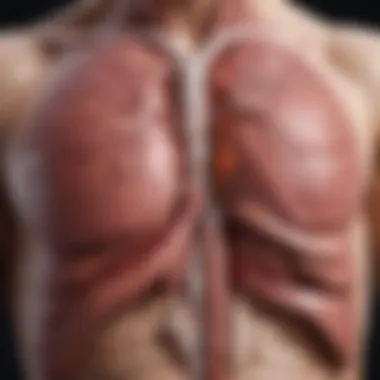Understanding Liver Irritation: Causes and Impacts


Intro
Irritation of the liver is a significant health concern that affects many individuals worldwide. This exploration delves into the complexities surrounding this crucial organ, highlighting its functions, potential irritants, and the implications of liver irritation on overall health. The liver, known for detoxification and metabolic processes, is vital for maintaining bodily homeostasis. When it faces irritation, the consequences can be severe, impacting not just liver function but also overall health.
The article will encompass an extensive overview of liver irritation, detailing its various causes such as alcohol consumption, viral infections, and certain medications. Symptoms can vary widely from mild discomfort to severe conditions requiring immediate medical attention. By synthesizing current research and clinical findings, this work seeks to provide a comprehensive understanding suitable for both scientific audiences and those interested in health.
The knowledge presented in this article aims to empower readers with insights into prevention strategies and treatment options. Awareness of liver irritation is critical for maintaining good health, especially in an age where lifestyle choices significantly affect liver function.
Prelims to Liver Function
The liver is a vital organ, playing a central role in maintaining the body's overall health. It is often referred to as the body's detoxification center, responsible for processing and clearing out various substances from the bloodstream. Understanding the function of the liver is crucial, especially in the context of liver irritation, as disturbances in this organ can have wide-ranging effects on bodily processes.
Overview of Liver Anatomy
The liver is situated in the upper right portion of the abdomen, just beneath the diaphragm. It is divided into two main lobes, which contain small structures called lobules. Each lobule consists of liver cells, known as hepatocytes, arranged around a central vein. These hepatocytes are responsible for various metabolic functions, including nutrient processing and detoxification.
The liver is richly supplied with blood from two sources: the hepatic artery and the portal vein. The hepatic artery delivers oxygenated blood from the heart, while the portal vein brings nutrient-rich blood from the gastrointestinal tract. This unique dual blood supply allows the liver to perform its essential functions effectively.
Functions of the Liver
The liver fulfills numerous functions that are critical for sustaining health. Some of the most important include:
- Metabolism of Nutrients: The liver metabolizes carbohydrates, proteins, and fats, converting them into usable energy or storing them for future use.
- Detoxification: It breaks down and removes toxins from the blood, including drugs and alcohol, which can cause irritation and damage if not properly processed.
- Production of Bile: The liver produces bile, a substance essential for digesting fats and absorbing fat-soluble vitamins.
- Storage of Vitamins and Minerals: It stores essential vitamins, such as A, D, E, K, and B12, along with important minerals like iron and copper.
- Synthesis of Proteins: The liver is the site of protein synthesis, producing albumin and clotting factors that are critical for maintaining blood pressure and preventing bleeding.
Understanding these functions highlights the intricate relationship between liver health and overall well-being. When the liver is irritated or impaired, these vital processes can be disrupted, leading to serious health consequences.
"The liver's multifaceted roles are indispensable to the normal functioning of the human body."
Fostering a deeper understanding of the liver's anatomy and function is imperative for any discussions regarding liver irritation, as it lays the groundwork for examining causes, symptoms, and management of liver-related conditions.
Understanding Liver Irritation
Understanding liver irritation is essential in grasping the full scope of liver health. The liver serves numerous critical functions, and any disruption can yield significant health consequences. This section delves into the concepts of definition and underlying mechanisms, setting a groundwork for exploring further into causes, symptoms, and management of liver irritation.
Definition and Significance
Liver irritation refers to a state where the liver tissue experiences inflammation or stress due to various internal or external factors. This condition can arise from multiple sources, including toxic substances, infections, and underlying health issues. Recognizing this irritation's significance is crucial, as it may evolve into more serious liver conditions if not addressed.
The liver, being central to metabolism and detoxification, is implicated in numerous bodily processes. When irritation occurs, it can disrupt these processes, leading to wider systemic effects. For instance, prolonged irritation may contribute to the development of liver diseases such as hepatitis, cirrhosis, or fatty liver disease, all of which have far-reaching health implications.
Pathophysiology of Irritation
The pathophysiology of liver irritation is complex, involving both immune responses and metabolic alterations. Initially, liver irritation typically arises from cellular injury. This injury activates inflammatory pathways, prompting immune cells to flood the area in response. As these immune cells engage with the affected liver tissue, they often release signaling molecules that can mitigate or exacerbate injury.
This process can initiate a feedback loop. For instance, persistent inflammation can lead to fibrosis, which is the buildup of scar tissue in the liver. Over time, fibrosis can progress, hindering liver function significantly. Moreover, chronic irritation may influence liver metabolism, altering lipid storage and processing, potentially leading to conditions like non-alcoholic fatty liver disease. Understanding these mechanisms is vital as they underscore the importance of early intervention and the potential for recovery.
"If liver irritation goes unchecked, it can cascade into severe health disparities, affecting not just liver functions but overall well-being."
Grasping these fundamental aspects of liver irritation play a pivotal role in the proactive management of liver health.


Common Causes of Liver Irritation
Understanding the common causes of liver irritation is critical for effectively managing liver health. This section covers various factors that contribute to the irritation of the liver. Each cause introduces different risks and implications for liver function, making it essential for individuals to be informed. Recognizing and addressing these factors can aid in both prevention and treatment of liver-related issues.
Alcohol Consumption
Alcohol consumption is one of the foremost causes of liver irritation. The liver acts as the primary site for alcohol metabolism, and excessive intake can lead to a range of issues. Chronic alcohol use can result in fatty liver disease, alcoholic hepatitis, and even cirrhosis. Each of these conditions signify varying degrees of liver irritation and damage.
While moderate alcohol consumption may not pose significant risks, heavy drinking consistently overwhelms the liver's capacity to detoxify. Individuals should remain vigilant about their drinking habits and understand that binge drinking or regular heavy use dramatically increases the likelihood of liver irritation.
Toxic Exposures
Environmental toxins can markedly affect liver health. Exposure to chemicals, such as those found in pesticides, industrial pollutants, and certain medications, can provoke liver irritation. These substances may cause cellular damage, prompting inflammation and hindered liver function.
Some individuals may be more vulnerable due to genetic factors or pre-existing liver conditions. Understanding the specific toxins one is exposed to in their daily environment—and minimizing that exposure—could mitigate risks effectively.
Infections and Inflammatory Conditions
Viral infections, including Hepatitis A, B, and C, significantly contribute to liver irritation. Hepatitis, primarily an inflammation of the liver, can lead to acute or chronic symptoms depending on the viral type and individual factors. Inflammation can cause a cascade of issues, disrupting the liver's ability to function.
In addition to viral causes, bacterial infections may also initiate irritation. The overall impact of infections on liver health should be acknowledged in any discussion surrounding liver conditions.
Autoimmune Disorders
In some cases, the immune system mistakenly attacks liver cells. Autoimmune disorders, such as autoimmune hepatitis, can lead to inflammation and irritation. The exact cause of these conditions is not always clear, but genetic predispositions and environmental triggers play significant roles.
Managing these disorders often involves immunosuppressive therapies to limit the immune response. Individuals should consult healthcare providers regarding the best approach based on their specific conditions.
Metabolic Syndromes
Metabolic syndromes encompass a range of conditions, including obesity, diabetes, and hyperlipidemia, all of which can stress the liver. Non-alcoholic fatty liver disease (NAFLD) is particularly notable, emerging as one of the most common liver problems related to metabolic disorders. These syndromes cause fat accumulation in the liver, potentially leading to further irritation and inflammation.
Addressing lifestyle factors, such as diet and physical activity, can help manage and prevent the development of these syndromes. Encouragingly, target changes can result in improvements in liver health and functionality.
Symptoms Associated with Liver Irritation
Understanding the symptoms associated with liver irritation is essential for early detection and intervention. The liver's role in metabolic processes and detoxification renders it susceptible to damage and dysfunction. Recognizing these symptoms can prevent progression to more severe liver diseases or complications. This section delves into the various physical symptoms and systemic manifestations that arise from liver irritation, offering a comprehensive view of how liver health can impact overall well-being.
Physical Symptoms
Physical symptoms of liver irritation can vary widely. These manifestations might hint at underlying issues and warrant further investigation. Common indicators include:
- Fatigue: A persistent sense of tiredness can result from the liver's decreased ability to detoxify substances.
- Abdominal Discomfort: Many individuals experience localized pain or discomfort in the upper right quadrant of the abdomen, indicating possible liver inflammation or enlargement.
- Jaundice: A yellowing of the skin and eyes occurs when bilirubin accumulates in the blood, often reflecting a liver that cannot process bilirubin efficiently.
- Appetite Changes: Many may experience lost appetite or unintentional weight loss, as the liver's function affects digestion and nutrient absorption.
- Nausea and Vomiting: These symptoms can be present, particularly after consuming fatty or rich foods, signaling the liver's struggle to metabolize them.
These physical signs are vital for understanding the liver's status. Notably, fatigue is often dismissed as a common symptom, but its relevance in liver disease cannot be overstated. Early recognition of these signs can lead to timely medical evaluation and intervention.
Systemic Manifestations
In addition to localized symptoms, liver irritation can also contribute to systemic manifestations that affect the body as a whole. These can be even more challenging to link directly to liver function but require attention nonetheless:
- Increased Bruising and Bleeding: Liver dysfunction affects the production of clotting factors, leading to easy bruising or an increased tendency to bleed.
- Hormonal Imbalances: Liver irritation can disrupt hormone metabolism, which may affect sexual function and cause irregular menstrual cycles in women.
- Cognitive Changes: Some individuals may experience confusion or memory issues as a result of hepatic encephalopathy, a condition arising from toxin buildup when the liver fails to filter effectively.
- Fluid Retention: Ascites, or fluid accumulation in the abdominal cavity, can occur due to increased pressure in the veins leading from the liver, indicating significant liver dysfunction.


The presence of systemic symptoms alongside physical manifestations can complicate the diagnosis but highlights the interconnectedness of liver health and overall systemic function.
Understanding both physical and systemic symptoms associated with liver irritation is crucial for monitoring liver health. Recognition of these signs allows patients and healthcare providers to engage in more proactive management strategies. This knowledge can lead to improved health outcomes and a better quality of life for individuals impacted by liver-related issues.
Diagnosis of Liver Irritation
The diagnosis of liver irritation is critical for understanding its impact on health. Early identification allows for timely intervention, which can prevent further complications. Given the liver's vast functions, including metabolism and detoxification, recognizing signs of irritation can lead to better outcomes. It is essential to appreciate the multifaceted approach needed for effective diagnosis. The assessment involves clinical evaluations, advanced imaging studies, and precise laboratory tests.
Clinical Evaluation
A clinical evaluation is the first step in diagnosing liver irritation. Healthcare providers often start by taking a detailed medical history. Patients may be asked about their alcohol intake, medication usage, and exposure to toxins. A comprehensive physical examination can reveal symptoms such as jaundice, abdominal tenderness, or enlarged liver, which can indicate possible irritation.
The healthcare provider will also consider the patient's risk factors and family history of liver disease. Once an initial assessment occurs, further investigations typically follow to quantify the severity of the irritation and establish an appropriate treatment plan.
Imaging Studies
Imaging studies are crucial in visualizing liver anatomy and identifying signs of irritation. Common techniques include ultrasound, CT scans, and MRI. Each method presents certain advantages. For example, ultrasound is non-invasive and can highlight fluid accumulation, while CT and MRI can provide detailed cross-sectional images of the liver structure.
These imaging modalities can help detect conditions such as fatty liver, cirrhosis, or tumors associated with liver irritation. By assessing the visual data, healthcare professionals can better understand the liver’s condition, guiding further diagnostic steps.
Laboratory Tests
Laboratory tests form an essential component in the diagnosis of liver irritation. Blood tests often include liver enzyme levels, bilirubin, and other markers that indicate liver function. Elevated levels of alanine aminotransferase (ALT) and aspartate aminotransferase (AST) suggest liver inflammation.
Furthermore, specific serological tests can identify underlying infections or autoimmune conditions. Testing for viral hepatitis, for instance, helps rule out infectious causes of irritation. The results from these laboratory tests provide valuable insights, allowing for an effective and targeted management strategy for liver health.
Management Strategies for Liver Irritation
Understanding how to manage liver irritation is vital for maintaining overall health and preventing more serious liver conditions. Effective management strategies focus on reducing exposure to irritants, promoting liver function, and supporting body health. Attention to lifestyle choices and timely medical intervention is of utmost importance. This section will explore practical approaches that patients and healthcare providers can take toward managing liver irritation.
Lifestyle Modifications
Making informed lifestyle modifications can significantly impact liver health. These changes are often the first step in managing liver irritation and may include:
- Dietary Choices: A balanced diet can reduce liver stress. It is advisable to incorporate antioxidants from fruits and vegetables, coupled with whole grains and lean proteins. Foods rich in omega-3 fatty acids, such as salmon and walnuts, can also support liver function.
- Hydration: Drinking enough water helps the liver flush out toxins effectively. Aim for at least eight glasses of water daily for optimal hydration.
- Avoiding Alcohol: Alcohol consumption is a leading cause of liver irritation. Limiting or abstaining from alcohol can prevent further damage and allow the liver to recover.
- Regular Exercise: Physical activity improves metabolism and helps maintain a healthy weight. Aiming for at least 150 minutes of moderate exercise weekly can be beneficial.
- Sleep Hygiene: Quality sleep is essential for liver health. Aim for 7 to 8 hours of quality sleep each night to promote recovery and metabolic processes.
Implementing these lifestyle modifications can create a more conducive environment for liver recovery and overall well-being.
Medical Treatments
When lifestyle modifications are not sufficient alone, medical treatments become crucial. The choice of treatment depends on the underlying cause of the liver irritation. Common medical interventions may include:
- Medications: Depending on the condition, medications may be prescribed to manage symptoms or treat underlying causes. Anti-inflammatory drugs or medications targeting specific infections are examples of potential treatments.
- Nutritional Supplements: Supplements such as milk thistle may be recommended to support liver health, though this should only be done under medical advice.
- Avoidance of Hepatotoxic Substances: Patients are strongly advised to minimize exposure to toxic substances, which can aggravate liver irritation. This includes some prescription medications, which may require careful review by healthcare providers.
- Regular Monitoring: Continuous assessment through blood tests and other diagnostic tools ensures that potential complications are identified early.
Proper medical management is essential, particularly in more severe cases, to prevent progression to liver disease.
Monitoring and Follow-Up
Continuous monitoring and follow-up are integral components of effective management strategies for liver irritation. These steps ensure that any potential issues are detected promptly and that treatment plans are adjusted as necessary. Elements of monitoring and follow-up arrangements may include:
- Regular Check-ups: Patients should have regular appointments with healthcare providers. This allows for evaluating liver function and adjusting treatment plans based on test results.
- Liver Function Tests: These blood tests help monitor enzymes and substances in the blood that reflect the liver's health. Abnormal levels often indicate irritation or damage to the liver.
- Follow-up Imaging: Periodic imaging studies like ultrasounds may be performed to assess liver structure and detect any significant changes or complications.
- Patient Education: Educating patients about symptoms that require urgent attention can contribute to better outcomes. Knowing when to seek help is crucial for effective management.


Monitoring and regular follow-ups create a framework for proactive management of liver irritation and help to ensure long-term liver health.
The Role of Nutrition in Liver Health
Nutrition plays a vital role in maintaining liver health and function. The liver is responsible for various metabolic processes, including detoxification, protein synthesis, and the production of biochemicals necessary for digestion. Poor dietary choices can lead to conditions that irritate or damage the liver, while a balanced diet can help support its functions and promote overall well-being. This section explores both the impact of nutrition on liver health and practical dietary recommendations that can benefit individuals dealing with liver irritation.
Understanding Nutritional Impact
The nutritional intake affects the liver in manifold ways. Certain nutrients can enhance liver function, while others may be harmful. For instance, high levels of saturated fats can lead to fatty liver disease, while antioxidants found in fruits and vegetables help neutralize free radicals and reduce oxidative stress.
Moreover, specific vitamins and minerals, such as B vitamins and zinc, play essential roles in liver metabolism. A deficiency in these nutrients can impair liver function. The consumption of refined carbohydrates and sugars must also be monitored, as excessive intake can contribute to insulin resistance and associated liver issues.
A balanced diet should ideally lower inflammatory markers and support liver repair.
"Nutrition is not only a key component to overall health but also critical in promoting healing within the liver."
Dietary Recommendations
A well-rounded diet is crucial for maintaining liver health. Below are some recommendations that focus on nourishing the liver while avoiding irritants:
- Increase Fruit and Vegetable Intake: Aim for a variety of colors to maximize nutrient diversity. Cruciferous vegetables, like broccoli and Brussels sprouts, have shown positive effects on liver detoxification.
- Incorporate Whole Grains: Foods like brown rice and quinoa provide essential fiber, which aids digestion and helps maintain stable blood sugar levels.
- Opt for Lean Proteins: Sources such as fish, skinless poultry, and legumes are beneficial. Omega-3 fatty acids found in fish can reduce inflammation and improve liver fat metabolism.
- Limit Alcohol Consumption: Reducing or eliminating alcohol intake can significantly decrease liver irritation and help prevent further damage.
- Stay Hydrated: Sufficient water intake supports liver function and detoxification processes.
- Avoid Processed Foods: Minimize the intake of foods high in saturated fats, sugars, and salt, as these can contribute to liver issues.
Implementing these dietary strategies can lead to improved liver health and potentially reduce the risk or severity of liver irritation. It is essential to adjust one's nutrition based on individual health needs and consult with healthcare professionals as necessary to create a suitable plan.
Research Directions and Future Perspectives
Understanding liver irritation involves many dimensions, and as research evolves, so too does the potential for innovative approaches to treatment and prevention. The importance of this topic lies in uncovering new therapies, genetic factors, and public health implications.
Emerging Therapies
In recent years, there has been a surge in the development of emerging therapies targeting liver irritation. These therapies often focus on addressing underlying causes, rather than merely alleviating symptoms. For instance, new medications aim to enhance liver detoxification processes or reduce inflammation. The use of biological agents that modulate immune responses also shows promise. Clinical trials are underway to test the effectiveness of drugs like Obeticholic acid, which is under evaluation for non-alcoholic fatty liver disease. Such therapies are not only revolutionary but also necessary, as traditional treatments often fall short.
Additionally, integrative approaches, combining pharmaceuticals with lifestyle interventions, can improve outcomes for patients. Personalized medicine, wherein treatments are tailored according to an individual's genetic makeup and specific health conditions, is gaining traction. This ensures a more effective and targeted approach, reducing the likelihood of adverse effects and improving user adherence to treatment plans.
Genetic Considerations in Liver Irritation
Genetic factors play a crucial role in the susceptibility and severity of liver irritation. Recent advancements in genomics have highlighted specific genetic mutations linked to liver diseases, such as PNPLA3, which affects lipid metabolism and may lead to conditions like Non-Alcoholic Fatty Liver Disease. Understanding these genetic elements allows for better risk assessment and early intervention strategies.
Research into the genome of patients suffering from liver irritation has also uncovered potential biomarkers for diagnosis and prognosis. Identifying such markers could facilitate earlier detection and tailored interventions.
Another important aspect is the role of epigenetics, which examines how environmental factors can modify gene expression. This area of research provides insight into how lifestyle choices, such as diet and alcohol consumption, can influence liver health at a genetic level. Thus, future research must focus on integrating genetic data with broader lifestyle and health information to develop comprehensive management strategies for liver irritation.
Understanding the evolving landscape of liver health is essential for developing effective therapies, and genetic research will play a pivotal role in this journey.
In summary, as research progresses in emerging therapies and genetic considerations, the implications for liver irritation management are substantial. Continued exploration of these areas holds the promise for innovative treatments and improved outcomes for those affected.
Closure and Final Thoughts
Understanding liver irritation encompasses a range of factors, from the biological mechanisms behind it to the lifestyle choices that can mitigate its impact. The liver, a paramount organ in human physiology, requires due attention to prevent dysfunction. This article has provided a comprehensive view of the causes of liver irritation, explored its symptoms, delved into diagnostic procedures, and examined the various management strategies. Each aspect is significant as it not only aids in identifying issues but also promotes proactive healthcare.
Summary of Key Points
- Functions of the Liver: The liver plays an instrumental role in metabolism, detoxification, and the synthesis of essential proteins.
- Causes of Irritation: Alcohol consumption, toxic exposures, infections, autoimmune disorders, and metabolic syndromes stand out as primary contributors.
- Symptoms: Physical symptoms like abdominal pain and fatigue, along with systemic manifestations, highlight the body's response to irritation.
- Diagnosis: A combination of clinical evaluations, imaging studies, and laboratory tests helps in accurate diagnosis.
- Management: Lifestyle adjustments, medical treatments, and regular monitoring are essential for effective management of liver health.
Importance of Continued Research
Continued research on liver irritation is crucial for several reasons. First, it broadens our understanding of pathophysiological processes. As new therapies emerge, they will need rigorous testing to determine efficacy and safety. Furthermore, genetic factors influencing liver health warrant exploration. Advancements in this field could lead to better prevention and treatment strategies. The interplay between nutrition and liver irritation also presents a fertile ground for future studies, as diet plays a key role in liver function.
"Understanding the liver's complexities is not just about treating illness; it is about fostering health."



